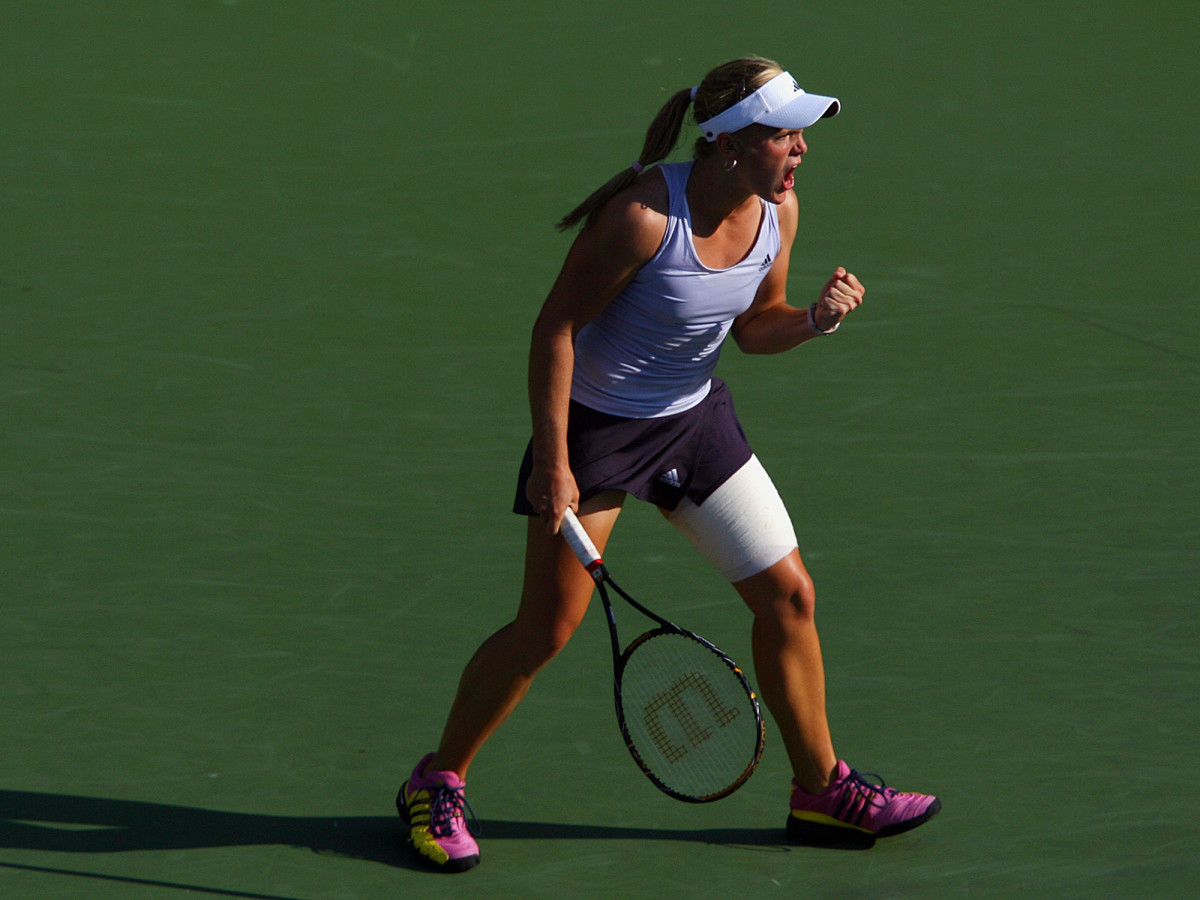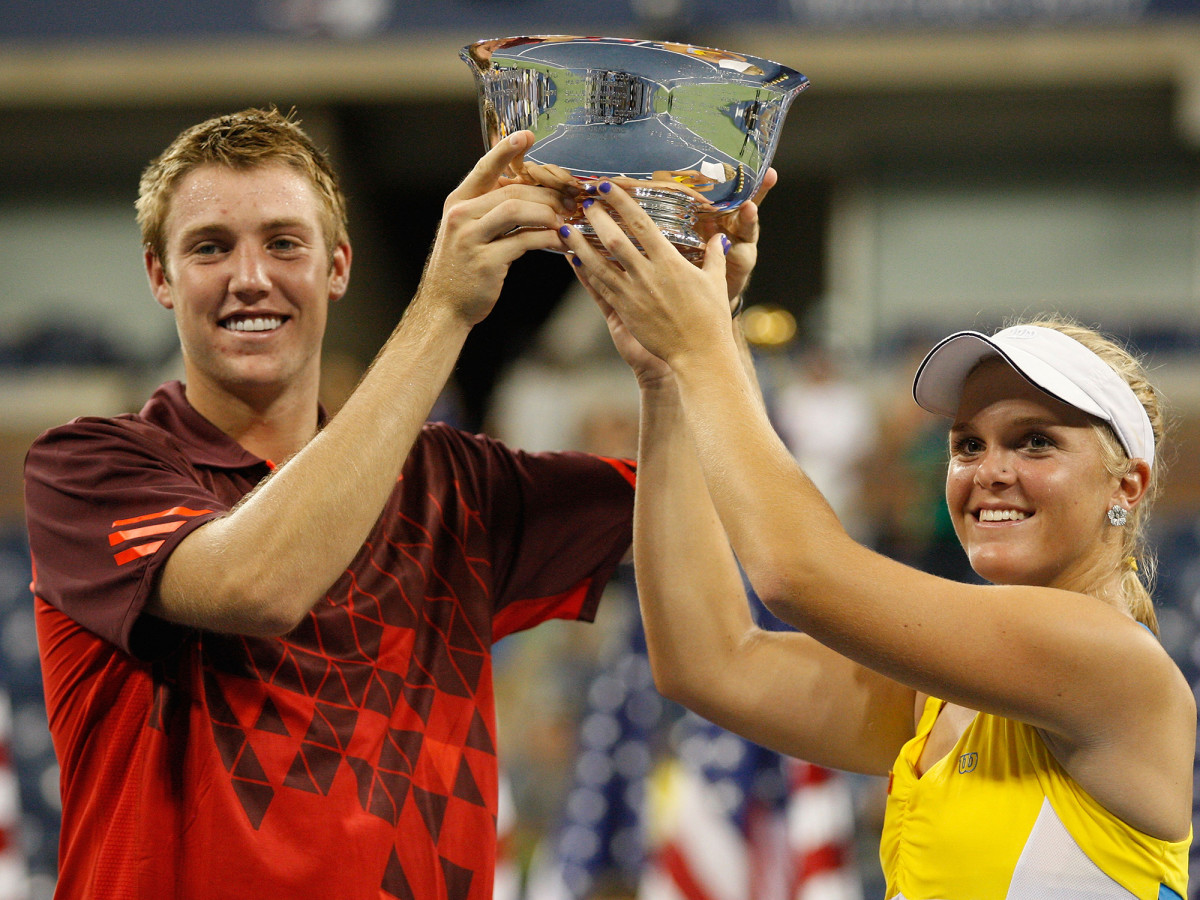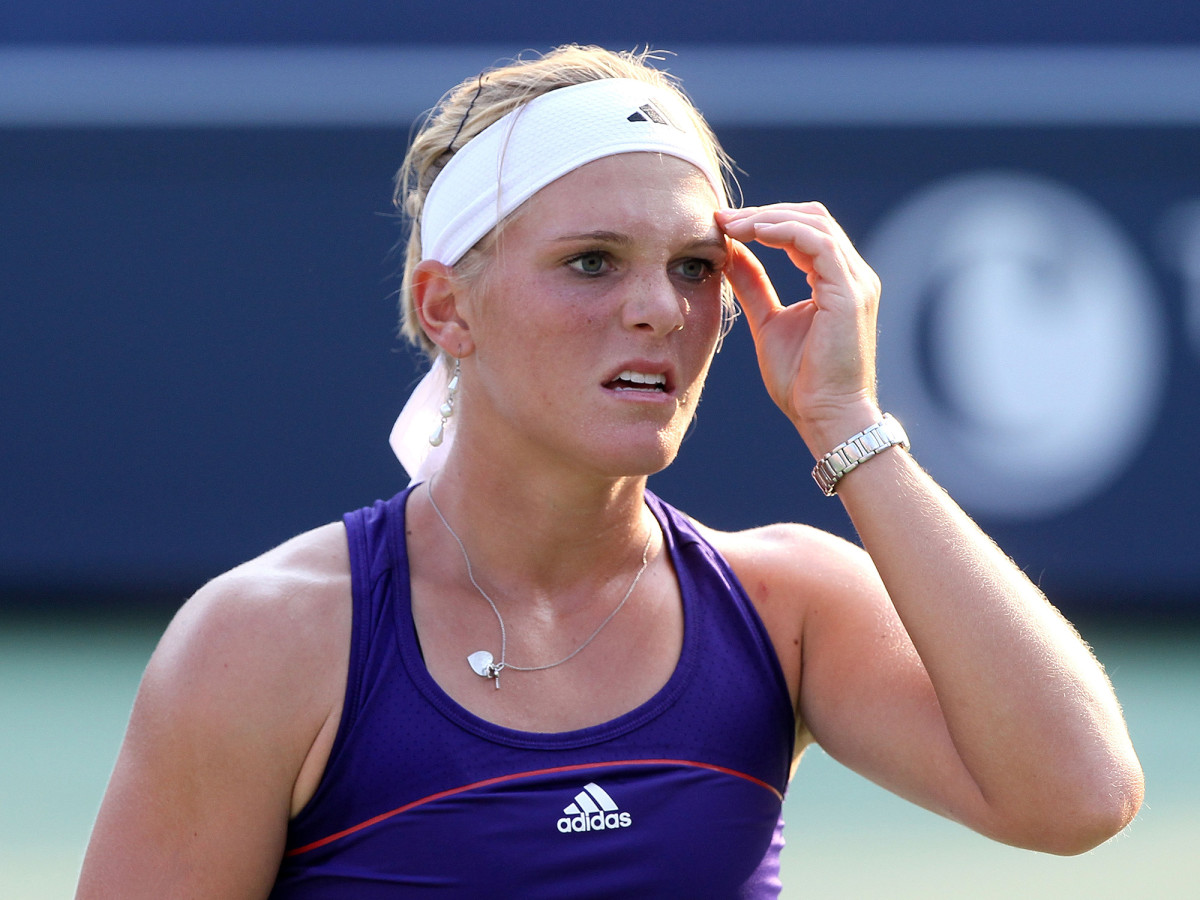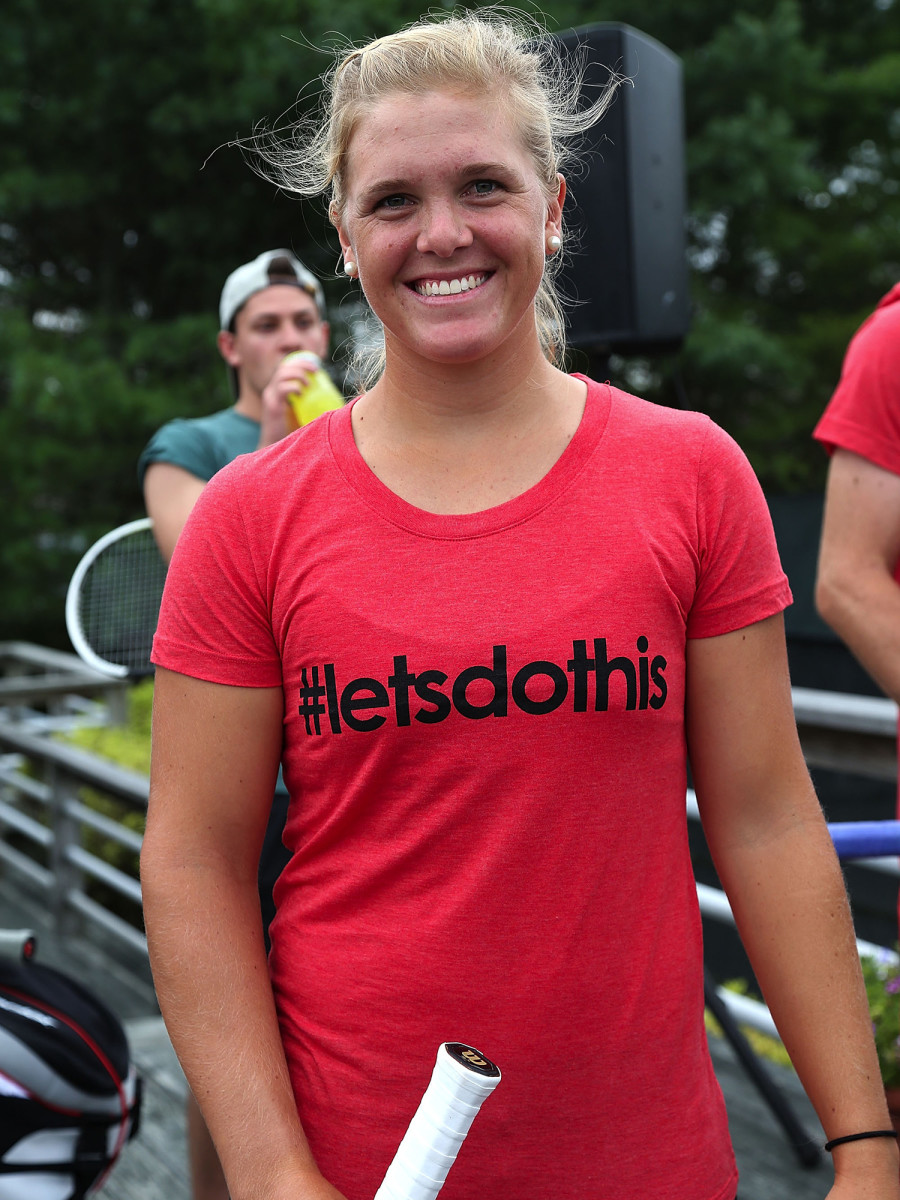Once a U.S. Open Cinderella story, Melanie Oudin details her journey back to health

Melanie Oudin made the quarterfinals of the 2009 U.S. Open at 17 years old, beating two top 15 players and Maria Sharapova, then a three-time Grand Slam champ, along the way. Headlines during the tournament included Melanie Oudin: The U.S. Open’s Cinderella Story, Oudin’s Wild Ride Reaches the Quarterfinals and How Much is Oudin Worth?
Five years later, Oudin no longer was the talk of Flushing Meadows, but rather one of 32 players in the final round of the 2014 U.S. Open Qualifying tournament. There, she was attempting to earn her spot in the main draw of the season’s final Grand Slam.
Oudin had cruised through her first two matches in just over two hours total. In the third round the American was up a break early in the first set against 18-year-old Ashleigh Barty.
“I was playing well,” said Oudin, who had not made the main draw of a major in over a year. “I was playing confident.”
Then the night match on Court 13 became a blur. Oudin’s heart started pounding uncontrollably, and as she lost control over her heartbeat she lost control of the match. Oudin was able to force a tiebreaker in the 66-minute opening set, but lost it, and the second set quickly followed.

“I was just pretty devastated that it happened during the match,” said Oudin, who was adamant that the attack was not an excuse. “It affected the way I played, the way I thought. It affected my whole body and it was really disappointing because even if I lost, I wanted to lose fair and square with me playing the best I could on that day.”
The match and her singles tournament were over, but her heartbeat kept thumping quickly. Oudin went back to her hotel where she could not eat. She could not sleep. For eight to ten hours, all she could do was hope that the thumping inside her chest would go away.
“It had been going so fast all night long and I had felt like I had just run a marathon or something,” Oudin said. “It was crazy. It was terrible.”
Then just 22 years old, she did not go to an emergency room, consult a doctor or tell anyone at all what was happening to her. She had felt the pounding before and during matches, but doctors who she had visited on the road told her she was having panic attacks. Tests showed that nothing was wrong with her heart. To Oudin, that meant the attacks were her fault. That long, disappointing night in New York was the worst it had ever been. It could not have been her fault. There was no way it was a panic attack.
“I’ve never felt anything like that in my entire life. I don’t wanna say that I felt like I was going to die, but I just felt like absolutely horrible,” Oudin said. “That was when I really knew, I really felt like something was wrong.”
Oudin was not as unknown as one would expect from a Cinderella at the 2009 U.S. Open. She reached as high as second in the world junior rankings by winning tournaments like the prestigious Easter Bowl and the Eddie Herr International Junior Championships—both as a 16-year-old.
“I think we only played maybe one time but I always looked up to her,” 2016 French Open quarterfinalist Shelby Rogers said. “She was an incredible junior player. I wanted to be that girl.”
Victoria Azarenka: Why watching the Rio Olympics has motivated me more than ever
Oudin broke into the top 100 of the WTA rankings at Wimbledon in 2009 when she made the fourth round, defeating World No. 6 Jelena Jankovic along the way. While Marcus Willis earned attention at the All England Club this year as the World No. 772, Oudin was No. 70 heading into the U.S. Open. She cruised by Anastasia Pavlyuchenkova in the first round before coming back from a set down against fourth seed Elena Dementieva, Maria Sharapova and then 13th-seed Nadia Petrova, throwing Arthur Ashe Stadium into a frenzy each time.
“I remember just how inspired I was by that run,” former World No. 24 Christina McHale, who earned a wild card into the event as a 17-year-old, said. “I think like she beat so many top, amazing players and I just remember it was such an inspiration seeing someone who I grew up playing juniors with and stuff doing so well.”
After losing to eventual finalist Caroline Wozniacki, Oudin worked her way up to as high as No. 31 in the world. In 2011, she won the U.S. Open mixed doubles title with Jack Sock and later her lone WTA crown in 2012.
“I don’t want people to define me just by that U.S. Open in 2009,” Oudin said. “I just feel like there have been a lot of other good things in my career.”

The success was short-lived, though. Oudin most recently fell out of the top 100 in June of 2013 when she failed to defend her lone title, which came on grass in Birmingham. The WTA lists Oudin at 5'6"—relatively undersized, as only five women in the top 20 are the same height or shorter. The sport has seen an increase in powerful baseliners, forcing smaller players like Oudin who may not have the strength to hit through opponents to find other ways to win.
“You can see the way she looks she won’t hurt you with a powerful serve, or she won’t hurt you with the killing shots,” former World No. 2 Vera Zvonareva once said of Oudin’s game. “She will make you play a lot of balls. She’s a good mover on the court. She’s one of those players that make you work to beat her.”
But working her way back up the rankings and to the level at which she proved she could play as a teenager was not just a matter of performance on-court.
“I had rhabdomyolysis, that crazy muscle condition,” Oudin said. “That was the first thing I really had at the end of 2012, the beginning of 2013.”
Rhabdomyolysis causes muscle weakness, fatigue and soreness—not ideal symptoms for a professional athlete who spends their time running around and hitting tennis balls for a living. But that was only the beginning.
For 2016, the U.S. Open adds more than a retractable roof
Towards the end of 2012, Oudin felt chest pain during a couple of matches. The next year, it slowly started happening more often, whether she was ahead in a match or behind—it even happened once when she won a set 6-0. But still, Oudin told no one. That was until one incident in 2013.
“It was like spring, summer, the end of a match. I couldn’t stand up and just feel good,” Oudin said. “I had to lay down. I couldn’t take a shower. I couldn’t eat. I just felt like my whole body it was almost like numb and I almost was going to pass out, but I wasn’t sure.”
The sensations subsided, but she finally decided to tell her mother, Leslie.
“She was just like, ‘Keep an eye on it you know, but I’m sure it could just be the adrenaline and everything from the match,’” Oudin recalled.
At the time, she did not think much of the attacks. They were nuisances, but “it wasn’t a big deal.” Maybe they were panic attacks. But the more they happened, the more that did not make sense. Oudin says that she never really felt stressed out. Yet sometimes the pain would come during two matches in a tournament.
“We need to get you to a doctor,” Oudin recalls her mother telling her. “This has happened too many times now.”
But no doctors she saw had a tangible solution.
“I was diagnosed having panic attacks,” Oudin said. “I never told anyone because I was embarrassed by it.”
Tennis is a lonely sport as it is. Playing singles, there is nobody on court to help you but yourself. The WTA Tour allows for coaching timeouts once per set during which the designee can only provide their advice and no physical assistance of any kind. Players cannot call on their coaches during Grand Slams. For the most part, competitors are completely isolated. With nothing to blame—tests did not show any heart problem—Oudin could not help but think that she may be causing her own pain.
“[It’s] something for sure that she struggled with because she thought it was her fault,” Rogers said. “She thought it was something that she couldn’t control and it was her that was messing everything up.”
Time and time again, her heart would beat out of her chest during matches. All Oudin could think was that she could not do anything about it. All she knew was that doctors told her that she was having panic attacks.
“It definitely freaked me out a little bit because I had no idea when it was going to happen and of course that was the biggest thing in my head, ‘I hope it doesn’t happen now. I’m in the middle of a match. I’m playing great and I can’t control when it would happen or if it didn’t happen’,” Oudin said. “Sometimes I’d have a three-hour, toughest match ever and it wouldn’t happen so it was just very, very random and pretty scary how I had no control over the feeling.”
Angelique Kerber misses chance to supplant Serena Williams at No. 1
In the middle of 2014, Oudin managed to win 10 of 13 matches to jump inside the top 150, despite the attacks. But at the end of the summer when the American was just a match away from qualifying for the U.S. Open and re-entering the top 125 in the process, she had the worst night of her health struggle. Oudin was up all night in her hotel. She was terrified, guessing her heart ran at around 215 beats per minute. (Athletes may normally have a resting heart rate of 40 to 60 beats per minute.) Eventually, the attack did subside, but the disappointment did not.
“That match I probably thought more of ‘oh my gosh I can’t believe this is happening now’,” said Oudin, who wanted to focus on the match. “It didn’t happen. My body didn’t let me do that.”
Oudin did not visit another doctor. She trusted what was a consistent diagnosis—she was having panic attacks. The 24-year-old even competed in both women’s doubles and mixed doubles at the U.S. Open—she reached the second round of the mixed doubles draw alongside Rajeev Ram. But just over a month later, it happened again. Another tournament, another set of abnormal heart rhythms—this time at a $50,000 tournament in Oudin’s home state of Georgia. Oudin’s grandmother took her to an urgent care, where her pulse was recorded at around 220 beats per minute.

“They looked at me and right away they were like, ‘It’s not a panic attack’,” Oudin said. “The next day I brought my EKG [electrocardiogram] to a cardiologist, a different cardiologist and he said right away that I have a type of SVT and it’s not a panic attack.”
“SVT” stands for supraventricular tachycardia, a type of arrhythmia or abnormal heart rhythm. SVTs generally come from the top of the heart, as opposed to cardiac arrest or similar incidents stemming from abnormal rhythms in the bottom of the heart. SVTs can range from annoying to recurrent and debilitating. That is not a panic attack, as Oudin was told repeatedly.
“Generally speaking you don’t die from them. One situation where it could be dangerous is if it happens so often that the heart muscle starts to get weak because your heart rate is constantly running a marathon all the time,” says Maimonides Medical Center’s Associate Director of Cardiac Electrophysiology, Dr. Felix Yang.
Dr. Yang did not treat Oudin, but commented on her situation. "It’s pretty impressive to be able to play any kind of serious, competitive sport when your blood pressure is probably lower during these episodes when your heart’s racing and you’re just pushing through it. I mean most people are even just uncomfortable sitting with the palpitations so if she’s actually pushing through that’s pretty remarkable.”
Oudin required a catheter ablation—a procedure in which a catheter is advanced through the lower body and up to the heart to introduce adrenaline, which stimulates the heart and allows doctors to locate what is usually an extra electrical fiber. That is then burnt off, hopefully eradicating the issue.
Camaraderie, cooking and Congress: Get to know John Isner off the court
In the same offseason Oudin also underwent a procedure to remove a growth from her eye, hoping that everything would be back to normal by the 2015 Australian Open.
But the heart problem persisted. Doctors told her to give it more time, that she had only endured a couple of incidents since the ablation. But when she continued to feel a rapid heartbeat, doctors did not know exactly what was wrong, giving Oudin more than just a health problem.
“Until they were able to figure out actually what was wrong, I wasn’t going to be able to play tennis,” Oudin said. “There was a chance of me not being able to play tennis again if they couldn’t figure out what was wrong because nobody would clear me to play. The WTA and ITF, they definitely wouldn’t clear me to play if I wasn’t cleared by the doctors. So that was definitely a little bit scary.”
Oudin became associated with the “BELIEVE” slogan that was engraved on her sneakers during her 2009 U.S. Open run. It is fitting that at her lowest point, belief is what she had to rely on—belief that one day this nightmare would end.
That offseason is when fellow players and friends began to find out what Oudin was going through.
“I remember I shed a few tears for her when I found out she was going through that,” Rogers said. “She’s one of my great friends and I’ve never really lost anyone close to me so it made me a little nervous for sure.”
Mailbag: What is the most fearsome weapon in tennis?
2005 U.S. Open semifinalist Robby Ginepri—who also had a heart arrhythmia—underwent a similar procedure in 2013. On his recommendation, Oudin saw Dr. Jacob Blatt, who identified the issue right away and corrected it through the same procedure last April. Since then, Oudin has not had another heart-related episode.
But as much of Oudin’s still-young career has gone, she could not catch a break. While preparing for a Challenger level tournament—the equivalent of a minor league event—last October, Oudin’s right hand started bothering her. When she woke up the morning of her first round match it was “huge,” and she withdrew only to find out later that she tore a muscle in the hand. 11 tournaments. That was how many she was able to play issue-free before facing a new obstacle.
“I was out for like eight weeks of literally doing nothing,” Oudin said. “Obviously every time you hit a shot I’m like putting pressure on that muscle and you hit so many shots every practice so it just took forever to actually heal.”
Even after everything she went through—what she called a “crazy” muscle condition, apparent panic attacks that turned out to be an arrhythmia, a failed heart procedure and an eye procedure, Oudin was not quite done yet.

“Despite all of the health hardships, she never once spoke about quitting or even wanting to take time off,” World No. 70 Alison Riske said. “Her positivity is something I admire so much and her passion for tennis is unlike anything I have witnessed.”
In a sense, Oudin wishes that she caused her health issues by failing to stretch, eating improperly or doing something that she could fix. But in recent years she has had no control. What is in her control now is where she goes next.
“The beauty about this sport is that there’s always next week and then it’s about getting healthy and she’s still relatively young and so there’s opportunity out there and the fact that she’s been playing the Challengers to get her points up, get her ranking up to get back to the main tour, says a lot,” USTA President Katrina Adams said. “If there’s anybody that has a positive attitude about life, it’s Melanie."
In March, Oudin started yet another comeback in the qualifying draw of a $25,000 Challenger in Florida—a long way from the U.S. Open’s Arthur Ashe Stadium, where she earned thousands of fans seven years ago. In a sense, Oudin’s struggle to get healthy reflects her tennis game—those close to her described her as a battler. She reached the U.S. Open quarterfinal by fighting for every point, and she will have to do it once again to earn plenty of ranking points—Oudin currently ranks at No. 281; she was at No. 392 for that first tournament of the season.
Juan Martin del Potro headlines U.S. Open wild cards
“She’s not going to give up and she’s not going to stop,” Rogers said. “She’s not going to let something like that hold her back. I’m confident in that.”
Looking back at her topsy-turvy journey, all Oudin knows is that right now she is virtually starting over. While the memories of her titles and magical U.S. Open run are nice, they do nothing to help her as she plays Challengers. But as she gets ready to play in the U.S. Open once more—the USTA awarded Oudin a wild card into the 2016 qualifying draw; she will play her first match on Wednesday—there is one thing that has not changed throughout her struggle. Oudin believes that she can do more than simply play tennis again.
“I feel like all my health issues are out of the way and I feel like I can really put my head down and work really hard in the next couple of years to really, really get back to where I want to be,” Oudin said. “There’s a lot more tennis in me to come and it’s just going to take a little bit of time to get it back.”
